Abstract
The expression of the gastrointestinal cancer associated antigen CA 19-9, defined by the monoclonal antibody 1116 NS 19-9, was studied by immunoperoxidase staining in routine formalin-fixed, paraffin-embedded tissue sections from normal pancreata, pancreata with pancreatitis and from benign and malignant pancreatic neoplasms. The formalin-fixed specimens were treated with pepsin, which enhanced the staining intensity. Eighty-five per cent of well to moderately differentiated adenocarcinomas were positive. The staining was most intense in the apical border of cells lining the lumina of malignant glands, and in mucus inside the lumina, but cytoplasmic staining was also seen. In poorly differentiated adenocarcinomas the number of positive cells was smaller and in anaplastic carcinomas only occasional cells were stained. All mucinous cystadenomas and cystadenocarcinomas stained intensely, whereas serous cystadenomas, and all benign and malignant islet cell tumours were negative. Ducts in chronic pancreatitis and in normal pancreata were positive in 96% and 79%, respectively, but the staining was focal and usually weaker than in carcinomas. In acute pancreatitis (92% positive) the staining was more intense, and the CA 19-9 expression was seen predominantly in small terminal ducts and in centroacinar cells. There was an apparent correlation between the degree of differentiation of the ductal adenocarcinomas and the expression of CA 19-9, whereas the correlation between tissue expression and serum levels of CA 19-9 was poor.
Full text
PDF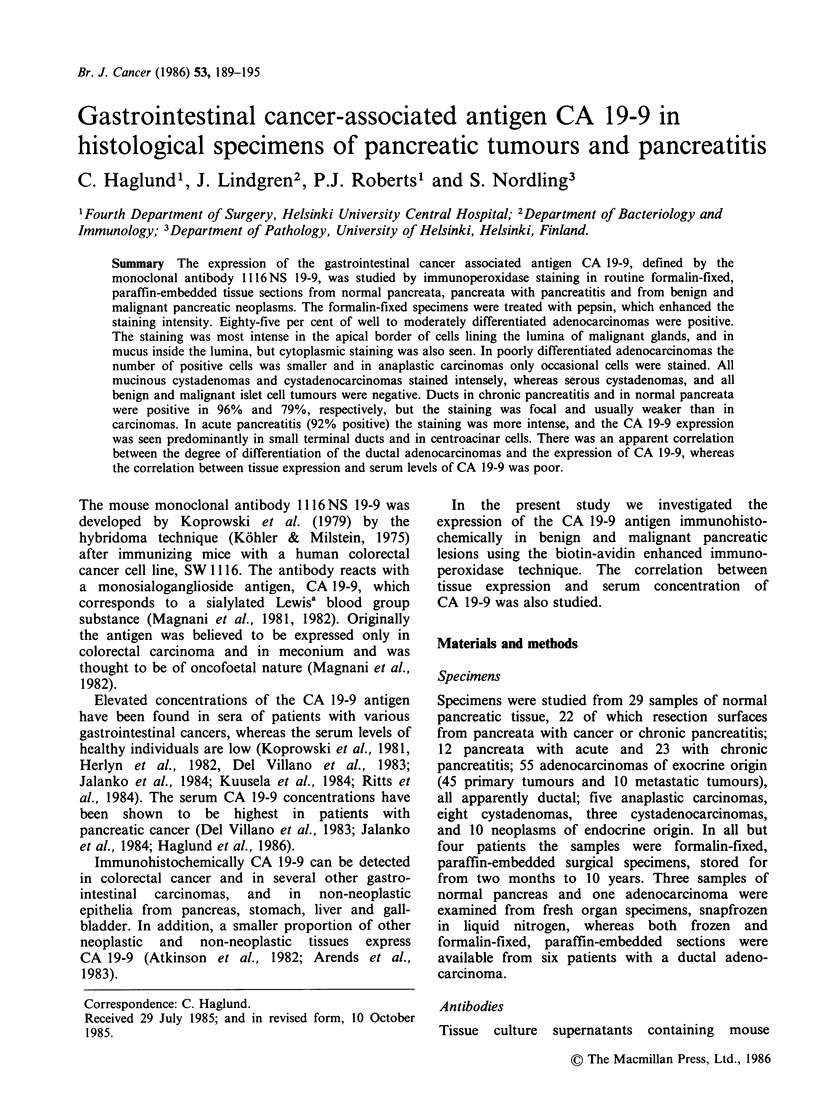
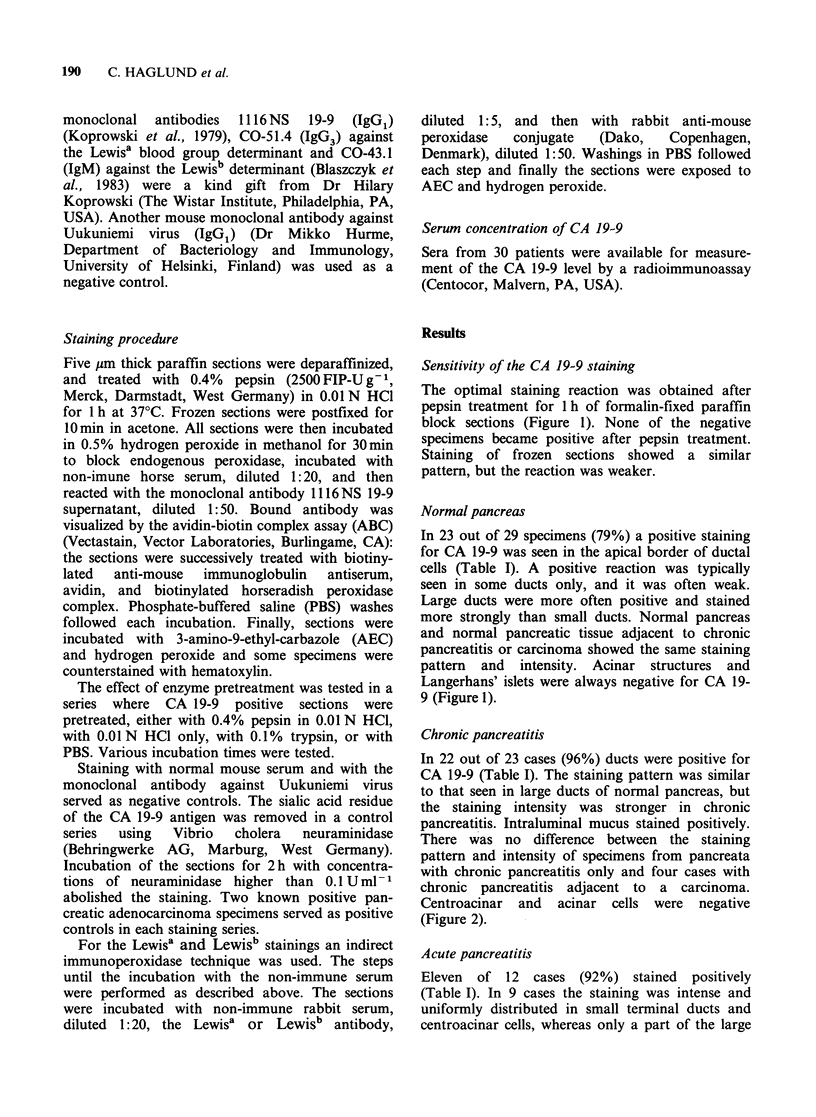
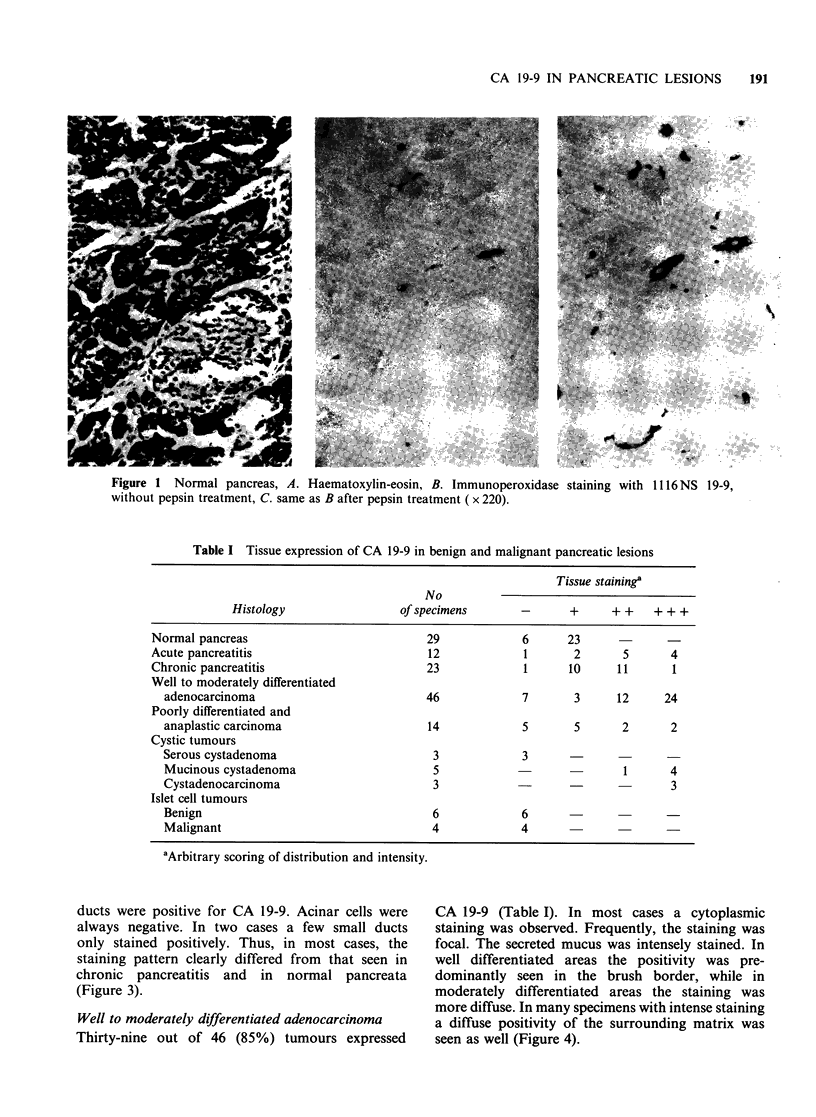
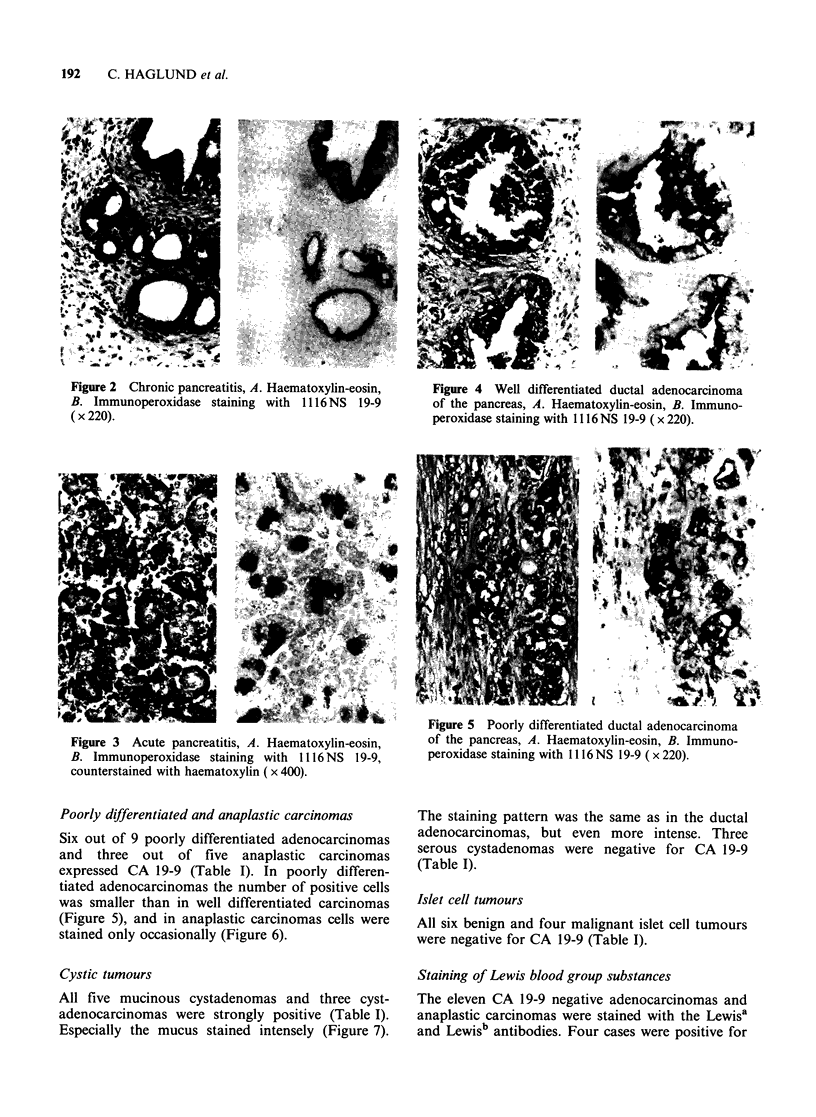
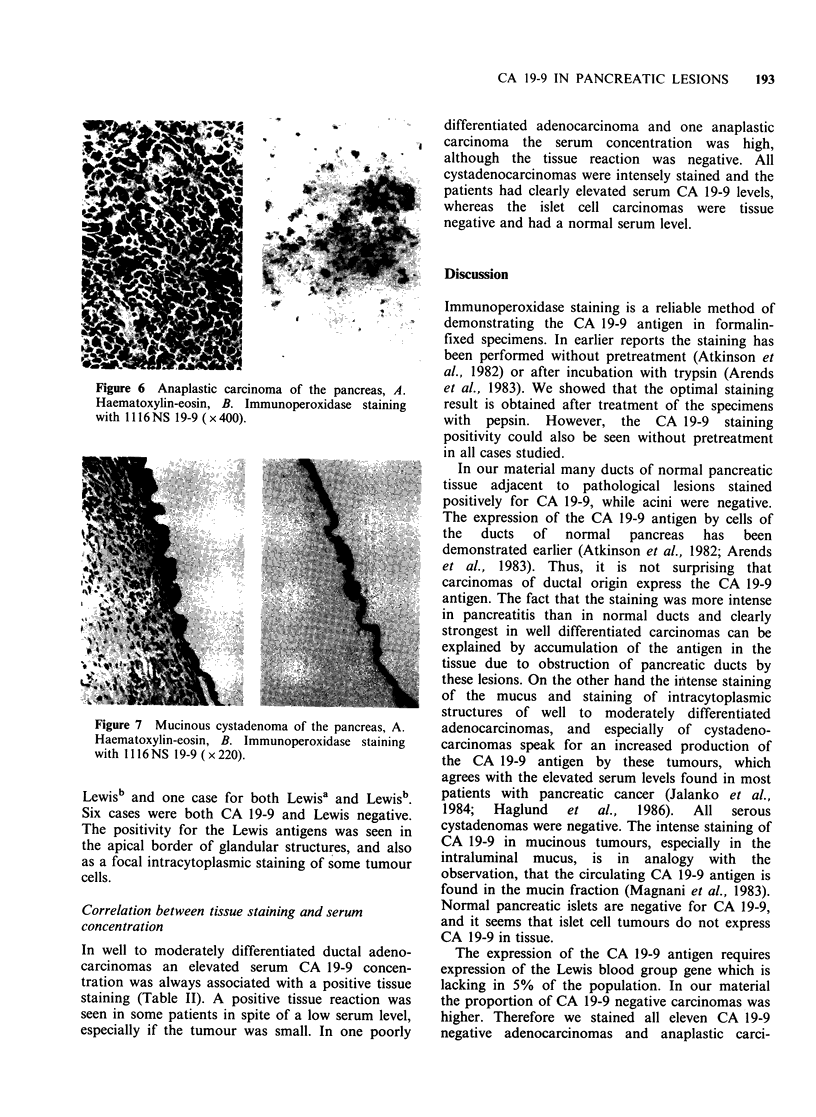
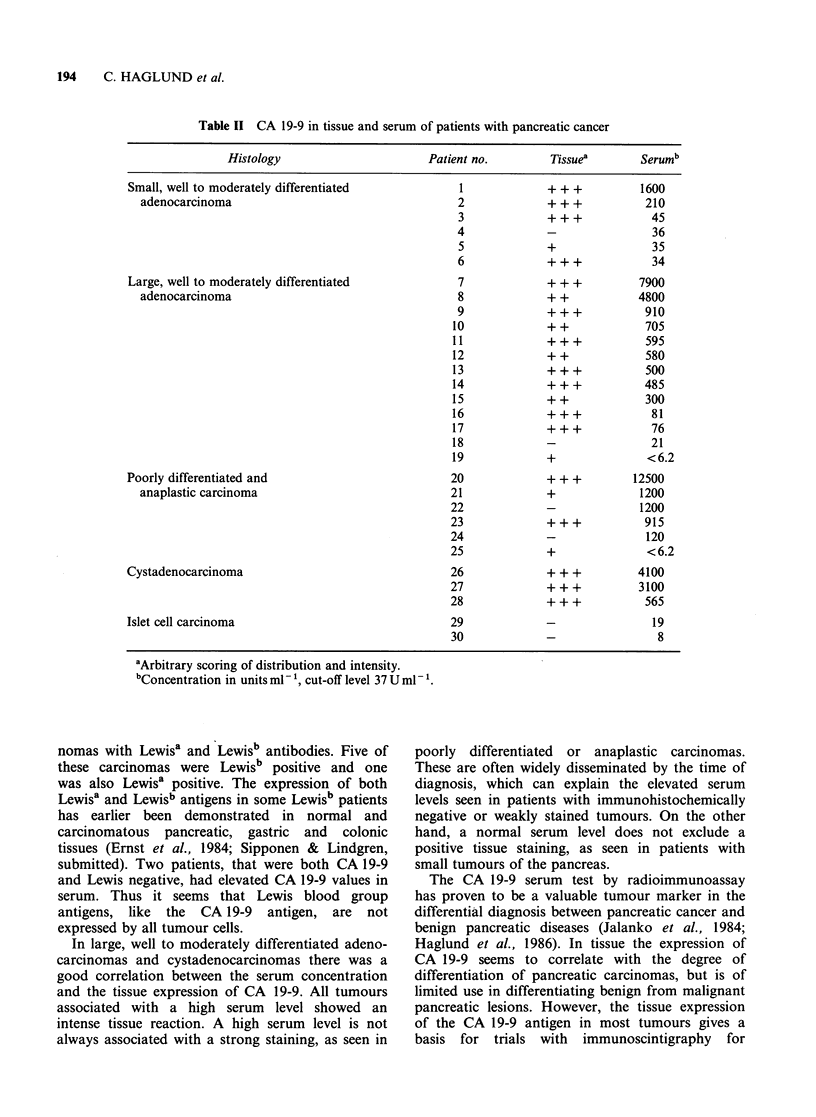
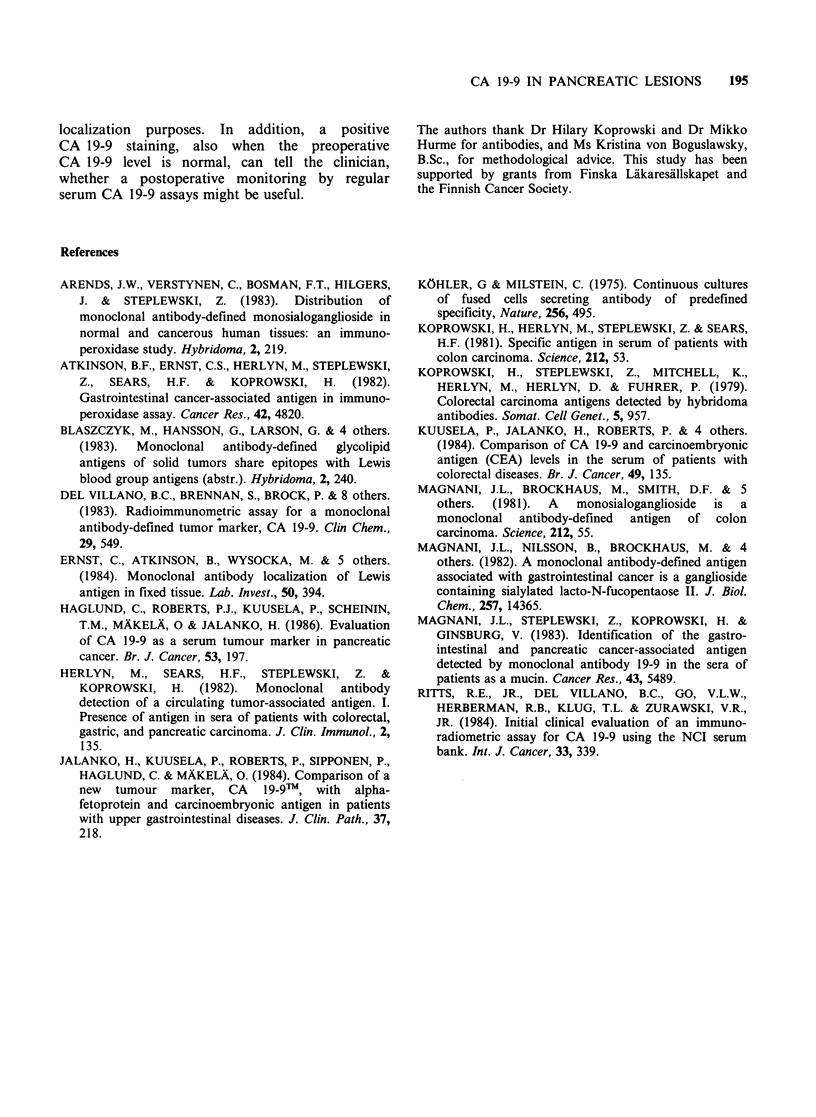
Images in this article
Selected References
These references are in PubMed. This may not be the complete list of references from this article.
- Arends J. W., Verstynen C., Bosman F. T., Hilgers J., Steplewski Z. Distribution of monoclonal antibody-defined monosialoganglioside in normal and cancerous human tissues: an immunoperoxidase study. Hybridoma. 1983;2(2):219–229. doi: 10.1089/hyb.1983.2.219. [DOI] [PubMed] [Google Scholar]
- Atkinson B. F., Ernst C. S., Herlyn M., Steplewski Z., Sears H. F., Koprowski H. Gastrointestinal cancer-associated antigen in immunoperoxidase assay. Cancer Res. 1982 Nov;42(11):4820–4823. [PubMed] [Google Scholar]
- Del Villano B. C., Brennan S., Brock P., Bucher C., Liu V., McClure M., Rake B., Space S., Westrick B., Schoemaker H. Radioimmunometric assay for a monoclonal antibody-defined tumor marker, CA 19-9. Clin Chem. 1983 Mar;29(3):549–552. [PubMed] [Google Scholar]
- Ernst C., Atkinson B., Wysocka M., Blaszczyk M., Herlyn M., Sears H., Steplewski Z., Koprowski H. Monoclonal antibody localization of Lewis antigens in fixed tissue. Lab Invest. 1984 Apr;50(4):394–400. [PubMed] [Google Scholar]
- Haglund C., Roberts P. J., Kuusela P., Scheinin T. M., Mäkelä O., Jalanko H. Evaluation of CA 19-9 as a serum tumour marker in pancreatic cancer. Br J Cancer. 1986 Feb;53(2):197–202. doi: 10.1038/bjc.1986.35. [DOI] [PMC free article] [PubMed] [Google Scholar]
- Herlyn M., Sears H. F., Steplewski Z., Koprowski H. Monoclonal antibody detection of a circulating tumor-associated antigen. I. Presence of antigen in sera of patients with colorectal, gastric, and pancreatic carcinoma. J Clin Immunol. 1982 Apr;2(2):135–140. doi: 10.1007/BF00916897. [DOI] [PubMed] [Google Scholar]
- Jalanko H., Kuusela P., Roberts P., Sipponen P., Haglund C. A., Mäkelä O. Comparison of a new tumour marker, CA 19-9, with alpha-fetoprotein and carcinoembryonic antigen in patients with upper gastrointestinal diseases. J Clin Pathol. 1984 Feb;37(2):218–222. doi: 10.1136/jcp.37.2.218. [DOI] [PMC free article] [PubMed] [Google Scholar]
- Koprowski H., Herlyn M., Steplewski Z., Sears H. F. Specific antigen in serum of patients with colon carcinoma. Science. 1981 Apr 3;212(4490):53–55. doi: 10.1126/science.6163212. [DOI] [PubMed] [Google Scholar]
- Koprowski H., Steplewski Z., Mitchell K., Herlyn M., Herlyn D., Fuhrer P. Colorectal carcinoma antigens detected by hybridoma antibodies. Somatic Cell Genet. 1979 Nov;5(6):957–971. doi: 10.1007/BF01542654. [DOI] [PubMed] [Google Scholar]
- Kuusela P., Jalanko H., Roberts P., Sipponen P., Mecklin J. P., Pitkänen R., Mäkelä O. Comparison of CA 19-9 and carcinoembryonic antigen (CEA) levels in the serum of patients with colorectal diseases. Br J Cancer. 1984 Feb;49(2):135–139. doi: 10.1038/bjc.1984.25. [DOI] [PMC free article] [PubMed] [Google Scholar]
- Köhler G., Milstein C. Continuous cultures of fused cells secreting antibody of predefined specificity. Nature. 1975 Aug 7;256(5517):495–497. doi: 10.1038/256495a0. [DOI] [PubMed] [Google Scholar]
- Magnani J. L., Nilsson B., Brockhaus M., Zopf D., Steplewski Z., Koprowski H., Ginsburg V. A monoclonal antibody-defined antigen associated with gastrointestinal cancer is a ganglioside containing sialylated lacto-N-fucopentaose II. J Biol Chem. 1982 Dec 10;257(23):14365–14369. [PubMed] [Google Scholar]
- Magnani J. L., Steplewski Z., Koprowski H., Ginsburg V. Identification of the gastrointestinal and pancreatic cancer-associated antigen detected by monoclonal antibody 19-9 in the sera of patients as a mucin. Cancer Res. 1983 Nov;43(11):5489–5492. [PubMed] [Google Scholar]
- Ritts R. E., Jr, Del Villano B. C., Go V. L., Herberman R. B., Klug T. L., Zurawski V. R., Jr Initial clinical evaluation of an immunoradiometric assay for CA 19-9 using the NCI serum bank. Int J Cancer. 1984 Mar 15;33(3):339–345. doi: 10.1002/ijc.2910330310. [DOI] [PubMed] [Google Scholar]
- Young C. C., Kofoid C. A., Johnstone H. G. Laboratory: The Cultivation of Endameba Gingivalis (Gros) from the Human Mouth. Am J Public Health Nations Health. 1929 May;19(5):549–552. doi: 10.2105/ajph.19.5.549. [DOI] [PMC free article] [PubMed] [Google Scholar]









